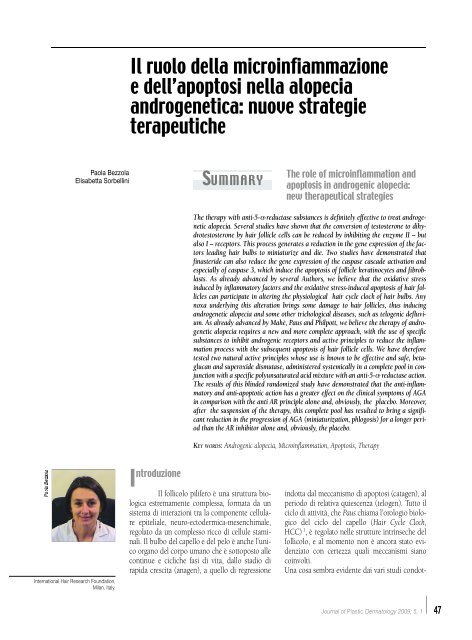Vol. 5, n. 1, January-March 2009 1th International ... - Salute per tutti
Vol. 5, n. 1, January-March 2009 1th International ... - Salute per tutti
Vol. 5, n. 1, January-March 2009 1th International ... - Salute per tutti
You also want an ePaper? Increase the reach of your titles
YUMPU automatically turns print PDFs into web optimized ePapers that Google loves.
Paola Bezzola<br />
Elisabetta Sorbellini<br />
<strong>International</strong> Hair Research Foundation,<br />
Milan, Italy.<br />
Il ruolo della microinfiammazione<br />
e dell’apoptosi nella alopecia<br />
androgenetica: nuove strategie<br />
terapeutiche<br />
SU M M A R Y<br />
I ntroduzione<br />
Il follicolo pilifero è una struttura biologica<br />
estremamente complessa, formata da un<br />
sistema di interazioni tra la componente cellulare<br />
epiteliale, neuro - e c t o d e r m i c a - m e s e n c h i m a l e ,<br />
regolato da un complesso ricco di cellule staminali.<br />
Il bulbo del capello e del pelo è anche l’unico<br />
organo del corpo umano che è sottoposto alle<br />
continue e cicliche fasi di vita, dallo stadio di<br />
rapida crescita (anagen), a quello di re g re s s i o n e<br />
The role of microinflammation and<br />
apoptosis in androgenic alopecia:<br />
new therapeutical strategies<br />
The therapy with anti-5-!- reductase substances is definitely effective to treat andro g enetic<br />
alopecia. Several studies have shown that the conversion of testosterone to dihyd<br />
ro t e s t o s t e rone by hair follicle cells can be reduced by inhibiting the enzyme II – but<br />
also I – receptors. This process generates a reduction in the gene expression of the factors<br />
leading hair bulbs to miniaturize and die. Two studies have demonstrated that<br />
finasteride can also reduce the gene expression of the caspase cascade activation and<br />
especially of caspase 3, which induce the apoptosis of follicle keratinocytes and fibro blasts.<br />
As already advanced by several Authors, we believe that the oxidative stre s s<br />
induced by inflammatory factors and the oxidative stress-induced apoptosis of hair follicles<br />
can participate in altering the physiological hair cycle clock of hair bulbs. Any<br />
noxa underlying this alteration brings some damage to hair follicles, thus inducing<br />
a n d rogenetic alopecia and some other trichological diseases, such as telogenic defluvium.<br />
As already advanced by Mahè, Paus and Philpott, we believe the therapy of androgenetic<br />
alopecia re q u i res a new and more complete approach, with the use of specific<br />
substances to inhibit androgenic receptors and active principles to reduce the inflammation<br />
process with the subsequent apoptosis of hair follicle cells. We have there f o re<br />
tested two natural active principles whose use is known to be effective and safe, betaglucan<br />
and su<strong>per</strong>oxide dismutase, administered systemically in a complete pool in conjunction<br />
with a specific polyunsaturated acid mixture with an anti-5-!- reductase action.<br />
The results of this blinded randomized study have demonstrated that the anti-inflamm<br />
a t o ry and anti-apoptotic action has a greater effect on the clinical symptoms of AGA<br />
in comparison with the anti AR principle alone and, obviously, the placebo. More o v e r,<br />
after the suspension of the therapy, this complete pool has resulted to bring a significant<br />
reduction in the pro g ression of AGA (miniaturization, phlogosis) for a longer <strong>per</strong>iod<br />
than the AR inhibitor alone and, obviously, the placebo.<br />
KE Y W O R D S: Androgenic alopecia, Microinflammation, Apoptosis, Therapy<br />
indotta dal meccanismo di apoptosi (catagen), al<br />
<strong>per</strong>iodo di relativa quiescenza (telogen). Tutto il<br />
ciclo di attività, che Paus chiama l’orologio biologico<br />
del ciclo del capello (Hair Cycle Clock,<br />
H C C ) 1 , è regolato nelle strutture intrinseche del<br />
follicolo, e al momento non è ancora stato evidenziato<br />
con certezza quali meccanismi siano<br />
c o i n v o l t i .<br />
Una cosa sembra evidente dai vari studi condot-<br />
Journal of Plastic Dermatology <strong>2009</strong>; 5, 1 47

















